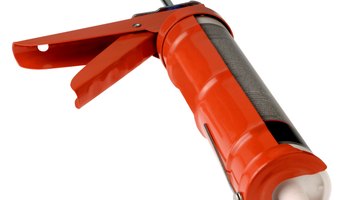Can Polyurethane Be Applied Over Silicone?
Polyurethane and silicone are two sealant options that create a durable finish along edges and seams. Polyurethane and silicone are available in several versions, but applying polyurethane over silicone will depend on which versions you are using.

Verify the type of polyurethane and silicone you have before attempting to use them together.
Standard Silicone Caulk
Silicone is a clear sealant caulk that has a durable, flexible structure. This structure makes silicone an ideal choice for applying along the frame edges of doors and windows, or to seal the edges of flooring and fixtures where gaps occur. When you apply liquid polyurethane onto a standard silicone surface, it will not stick properly to the flexible, clear surface of the silicone.
Paintable Silicone Caulk
Paintable silicone caulk is a variety of silicone that liquid polyurethane sealer will adhere to. This type of silicone caulk is more costly than standard silicone caulk, but it might be worth it if you need to apply a polyurethane sealer. One negative aspect of paintable silicone caulk is that you must apply the polyurethane within 48 hours of affixing the caulk to the surface in order to effectively seal it.
Polyurethane Caulk
Polyurethane caulk differs from silicone in that it adheres well to porous surfaces, such as bricks and cement, but not when applied on top of silicone. The instructions on a tube of caulk recommend that you remove existing caulk before applying a new layer. Applying a layer of polyurethane caulk over a silicone caulk will not give you adequate results and properly seal the area.
Considerations
Consider removing standard silicone caulk from the area before painting the area with a layer of polyurethane. You can then reapply the silicone on top of the polyurethane to seal the area. Attempt to smooth the silicone surface at the time of application if you plan to paint a polyurethane sealer on top. This will give a seamless appearance, instead of a thick beading of caulk.
The Drip Cap
- Polyurethane and silicone are two sealant options that create a durable finish along edges and seams.
- This type of silicone caulk is more costly than standard silicone caulk, but it might be worth it if you need to apply a polyurethane sealer.
- Applying a layer of polyurethane caulk over a silicone caulk will not give you adequate results and properly seal the area.
References
Writer Bio
Jennifer Loucks has been writing since 1998. She previously worked as a technical writer for a software development company, creating software documentation, help documents and training curriculum. She now writes hobby-based articles on cooking, gardening, sewing and running. Loucks also trains for full marathons, half-marathons and shorter distance running. She holds a Bachelor of Science in animal science and business from University of Wisconsin-River Falls.
Photo Credits
- Brand X Pictures/Brand X Pictures/Getty Images
- Brand X Pictures/Brand X Pictures/Getty Images
More Articles



